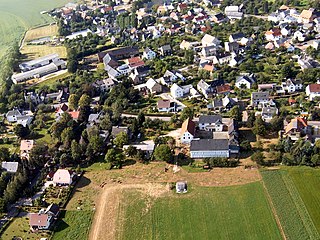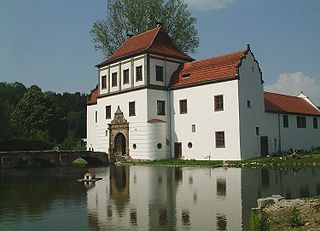
Reuss was the name of several historical states located in present-day Thuringia, Germany. Several lordships of the Holy Roman Empire which arose after 1300 and became Imperial Counties from 1673 and Imperial Principalities in the late 18th century were ruled by the House of Reuss.

Countess Augusta Caroline Sophie Reuss-Ebersdorf, was by marriage the Duchess of Saxe-Coburg-Saalfeld. She was the maternal grandmother of Queen Victoria and the paternal grandmother of Albert, Prince Consort.

Moritzburg is a municipality in the district of Meissen in Saxony, Germany, between Meissen itself, an early centre of Saxony, and today's capital Dresden. It is most famous for its Baroque castle, Schloss Moritzburg.

Crimmitschau is a town in the district of Zwickau in Saxony, Germany.

Bad Elster is a spa town in the Vogtlandkreis district, in Saxony, Germany. It lies on the border of Bavaria and the Czech Republic in the Elster gebirge hills. It is situated on the river White Elster, and is protected from extremes of temperature by the surrounding wooded hills. It is 25 km southeast of Plauen, and 25 km northwest of Cheb. It is part of the Freunde im Herzen Europas microregion.

Dahlen is a town in the district Nordsachsen, in Saxony, Germany. Since 1994, the town of Dahlen consists of the old town with the addition of neighbouring villages Börln with Bortewitz, Radegast and Schwarzer Kater, Großböhla, Neuböhla and Kleinböhla, Schmannewitz and Ochsensaal.

Hartenstein is a town in the Zwickau district, in Saxony, Germany. It is situated on the river Zwickauer Mulde, 14 km southeast of Zwickau.

Mügeln is a town in the district Nordsachsen, in Saxony, Germany. It is located 9 km southwest of Oschatz and 14 km northwest of Döbeln. The town has a population of approximately 4700 people.

Saalburg-Ebersdorf is a town in the Saale-Orla-Kreis district, in Thuringia, Germany close to the Bavarian border. It is situated on the river Saale, 10 km southwest of Schleiz, 30 km west of Plauen and 30 km north-west of Hof.

Prince Albert of Saxe-Altenburg was a German prince of the ducal house of Saxe-Altenburg.

Francis, Duke of Saxe-Coburg-Saalfeld, was one of the ruling Thuringian dukes of the House of Wettin. As progenitor of a line of Coburg princes who, in the 19th and 20th centuries, ascended the thrones of several European realms, he is a patrilineal ancestor of the royal houses of Belgium, Bulgaria and Portugal, as well as of several queen consorts.

Hainewalde is a village in Germany on the river Mandau, in the Bundesland of Saxony and the district Görlitz, historically belonging to Upper Lusatia. The village is part of the administrative partnership Großschönau-Waltersdorf.

Klipphausen is a municipality in the district of Meißen, in Saxony, Germany.

Machern is a municipality in the Leipzig district in Saxony, Germany. It is in the vicinity of the city of Leipzig.

Woizlawa Feodora Princess Reuss was a German royal and by birth member of the House of Mecklenburg-Schwerin. At the time of her death at the age of 100, she was the oldest living royal and the oldest living resident of Görwihl.

Heinrich LXVII, Prince Reuss Younger Line was Prince Reuss Younger Line from 1854 to 1867.

Heinrich XIV, Prince Reuss Younger Line was Prince Reuss Younger Line from 1867 to 1913.

Heinrich XLV, Prince Reuss Younger Line was the head of the House of Reuss from 1928 to 1945, as well the last male member of the Reuss-Schleiz branch of the Younger Line.

Heinrich XIII Prinz Reuss is a German businessman, far-right and monarchist activist, and member of a former aristocratic family. A proponent of the Reichsbürger movement and antisemitic conspiracy theories, Reuss was arrested by German federal police in December 2022 due to his alleged leadership in the 2022 German coup d'état plot.
Heinrich Reuss is the name of many male members from the German noble House of Reuss:

























